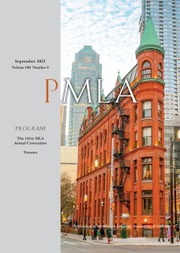No CrossRef data available.
Article contents
Persianate Unfamiliarity: A Qaṣīda by Shawkat Bukhārī to Imam al-Rizā
Published online by Cambridge University Press: 26 July 2024
Abstract
An abstract is not available for this content so a preview has been provided. Please use the Get access link above for information on how to access this content.

- Type
- Theories and Methodologies
- Information
- Copyright
- Copyright © 2024 The Author(s). Published by Cambridge University Press on behalf of Modern Language Association of America
References
Works Cited
Amanat, Abbas. “Remembering the Persianate.” The Persianate World: Rethinking a Shared Sphere, edited by Amanat, Assef Ashraf, , Brill, 2018, pp. 15–62, https://doi.org/10.1163/9789004387287_003.CrossRefGoogle Scholar
Ashraf, Assef. “Pathways to the Persianate.” Introduction. The Persianate World: Rethinking a Shared Sphere, edited by Amanat, Abbas and Ashraf, , Brill, 2018, pp. 1–14, https://doi.org/10.1163/9789004387287_002.Google Scholar
Bausani, Alessandro. “La letteratura neopersiana.” La letteratura persiana, edited by Pagliaro, Antonino and Bausani, , G. C. Sansoni / Accademia, 1968, pp. 131–563.Google Scholar
Bonebakker, Seeger Adrianus. Some Early Definitions of the Tawriya and Ṣafadī's Faḍḍ al-Xitām ʿan at-Tawriya wa-ʾl-Istixdām. Mouton, 1966.Google Scholar
Bowles, Henry M. “Linguistic Realism and Modernity: The Ontology of the Poetic from Suhrawardī to Ṣāʾib.” Persian Literature and Modernity: Production and Reception, edited by Yazdi, Hamid Rezaei and Mozafari, Arshavez, Routledge, 2019, pp. 112–40.Google Scholar
Chalisova, Natalia. “Ihām.” Encyclopedia Iranica, 2012, www.iranicaonline.org/articles/iham.Google Scholar
Changī, Darvīsh ʿAlī. رساله ی موسیقی [Risala-yi musiqi]. Institute of Oriental Manuscripts, Russian Academy of Sciences, Saint Petersburg, MS D403.Google Scholar
Faruqi, Shamsur Rahman. “A Stranger in the City: The Poetics of Sabk-e Hindi.” Annual of Urdu Studies, vol. 19, 2004, pp. 1–93, digital.library.wisc.edu/1793/18639.Google Scholar
Green, Nile. “The Frontiers of the Persianate World (ca. 800–1900).” Introduction. The Persianate World: The Frontiers of a Eurasian Lingua Franca, edited by Green, U of California P, 2019, pp. 1–71.Google Scholar
Hartman, Geoffrey. “The Voice of the Shuttle: Language from the Point of View of Literature.” The Review of Metaphysics, vol. 23, no. 2, 1969, pp. 240–58. JSTOR, www.jstor.org/stable/20125534.Google Scholar
Hemmat, Kaveh. “Review Essay: Completing the Persianate Turn.” Iranian Studies, vol. 54, nos. 3–4, 2021, pp. 633–46, https://doi.org/10.1080/00210862.2020.1810385.CrossRefGoogle Scholar
Inan, Murat Umut. “Imperial Ambitions, Mystical Aspirations: Persian Learning in the Ottoman World.” The Persianate World: The Frontiers of a Eurasian Lingua Franca, edited by Green, Nile, U of California P, 2019, pp. 75–92.Google Scholar
Keshavmurthy, Prashant. “Climbing with Ṣāʾeb, Sinking with Ghanī: A Comparison of Two Ghazals on Poetry.” International Journal of Persian Literature, vol. 2, no. 1, 2017, pp. 42–56, https://doi.org/10.5325/intejperslite.2.1.0042.CrossRefGoogle Scholar
Kia, Mana. Persianate Selves: Memories of Place and Origin before Nationalism. Stanford UP, 2020.10.1515/9781503611962CrossRefGoogle Scholar
Kinra, Rajeev. Writing Self, Writing Empire: Chandar Bhan Brahman and the Cultural World of the Indo-Persian State Secretary. U of California P, 2015.CrossRefGoogle Scholar
Kovacs, Hajnalka. “Challenges of and Strategies for Translating Indo-Persian Poetry and Prose: The Case of Bedil (1644–1720).” The Routledge Handbook of Persian Literary Translation, edited by Shabani-Jadidi, Pouneh et al., Routledge, 2022, pp. 110–30.10.4324/9781003052197-8CrossRefGoogle Scholar
Losensky, Paul. Welcoming Fighānī: Imitation and Poetic Individuality in the Safavid-Mughal Ghazal. Mazda Publishers, 1998.Google Scholar
Malīhā Samarqandī, Muhammad Badīʿ ibn Muhammad Sharīf Samarqandī. مذکّر الاصحاب [Muzakkir al-ashab]. Edited by Muhammad Taqavi, Kitabkhana, Muzih va Markaz-i Asnad-i Majlis-i Shura-yi Islami, 2011.Google Scholar
Martínez Alfaro, María Jesús. “Intertextuality: Origins and Development of the Concept.” Atlantis, vol. 18, nos. 1–2, 1996, pp. 268–85. JSTOR, www.jstor.org/stable/41054827.Google Scholar
McChesney, Robert D. “‘Barrier of Heterodoxy’? Rethinking the Ties between Iran and Central Asia in the Seventeenth Century.” Safavid Persia: The History and Politics of an Islamic Society, edited by Melville, Charles, I. B. Tauris, 1996, pp. 231–67.Google Scholar
McChesney, Robert D. “Earning a Living: Promoting Islamic Culture in the Sixteenth and Seventeenth Centuries.” Afghanistan's Islam: From Conversion to the Taliban, edited by Green, Nile, U of California P, 2016, pp. 89–104, https://doi.org/10.1525/9780520967373-010.Google Scholar
Melvin-Koushki, Matthew. “Early Modern Islamicate Empire: New Forms of Religiopolitical Legitimacy.” The Wiley-Blackwell History of Islam, edited by Salvatore, Armando et al., Wiley-Blackwell, 2018, pp. 353–75.Google Scholar
Mikkelson, Jane. “Color's Fracture: Translating Fugitive Experience in Early Modern Persian Poetry.” The Routledge Handbook of Persian Literary Translation, edited by Shabani-Jadidi, Pouneh et al., Routledge, 2022, pp. 247–85.CrossRefGoogle Scholar
Parsapajouh, Sepideh. “The Topography of Corporal Relics in Twelver Shiʿism: Some Anthropological Reflections on the Places of Ziyāra.” Journal of Material Cultures in the Muslim World, vol. 1, nos. 1–2, 2021, pp. 199–225, https://doi.org/10.1163/26666286-12340009.CrossRefGoogle Scholar
Pollock, Sheldon. “The Death of Sanskrit.” Comparative Studies in Society and History, vol. 43, no. 2, 2001, pp. 392–426. JSTOR, www.jstor.org/stable/2696659.CrossRefGoogle Scholar
Pritchett, Frances W. Nets of Awareness: Urdu Poetry and Its Critics. U of California P, 1994.Google Scholar
Pritchett, Frances W. “The Sky in an Ant's Egg: Ġhālib's Structural Poetics.” Journal of Urdu Studies, vol. 1, no. 1, 2020, pp. 53–66, https://doi.org/10.1163/26659050-12340006.CrossRefGoogle Scholar
Reĭsner, M. L. Визуальные образы красоты слова в персидской поэзии XVI–начала XVIII века: индийский стиль и живописание словом [“Vizualʿnye obrazy krasoty slova v persidskoĭ poėzii XVI–nachala XVIII veka: Indiĭskiĭ stilʿ i zhivopisanie slovom”]. RUDN Journal of Philosophy, vol. 24, no. 1, 2020, pp. 12–22, https://doi.org/10.22363/2313-2302-2020-24-1-12-22.Google Scholar
Şafak, Turgay, editor. تصحیح انتقادی دیوان شوکت بخارایی [Tashih-i intiqadi-yi divan-i Shawkat Bukhara'i]. 1386 [2007]. Danishgah-i Tehran, PhD dissertation.Google Scholar
Sāʾib Tabrīzī, Muhammad ʿAlī. دیوان [Divan]. Edited by Qahraman, Muhammad, Shirkat-i Intisharat-i ʿIlmi va Farhangi, 1985–91. 6 vols.Google Scholar
Sayyidā Nasafī, Mīr ʿĀbid. دیوان [Divan]. Edited by Rahbari, Hasan, Al-Huda, 1382 [2003].Google Scholar
Shafiʿi-Kadkani, Muhammad Riza. شاعر آینه ها : بررسی سبک هندی و شعر بیدل [Shaʿir-i ayinaʾha: Barrasi-yi sabk-i Hindi va shiʿr-i Bidil]. Muʾassasa-yi Intisharat-i Agah, 1366 [1987/1988].Google Scholar
Shawkat Bukhārī, Muhammad Ishāq. دیوان اشعار شوکت بخارایی [Divan-i ashʿar-i Shawkat Bukharaʾi]. Edited by Dadʿalishayif, Jabilqa et al., Nashriyat-i Danish, 1987.Google Scholar
Shawkat Bukhārī, Muhammad Ishāq. دیوان شوکت بخارى : شاعر سبک هندى نیمۀ دوم قرن یازدهم [Divan-i Shawkat Bukhari: Shaʿir-i sabk-i Hindi-yi nima-yi duvvum-i qarn-i yazdahum]. Edited by Shamisa, Sirus, Intisharat-i Firdaws, 1382 [2003/2004].Google Scholar


